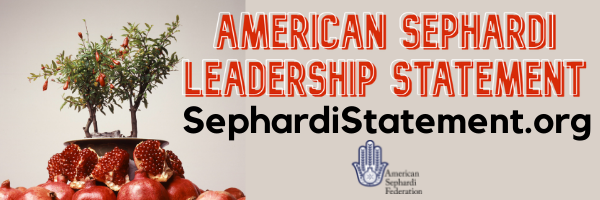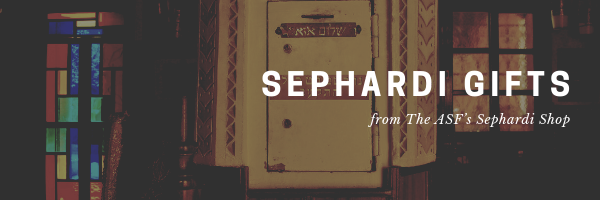Mazal tov to Julia Jassey and Isaac de Castro, Co-Founders of Jewish on Campus and both ASF Broome & Allen Scholars, who will be honored on Sunday (12 December) at the ADL’s “Concert Against Hate” for “Fighting Antisemitism” as “Creators, Conveners, Influencers”!
The Sephardi World Weekly is made possible by Professor Rifka Cook, Maria Gabriela Borrego Medina, Rachel Amar, Deborah Arellano, and Distinguished ASF Vice President Gwen Zuares!
Click here to dedicate a future issue in honor or memory of a loved one
🎨 “1st joint UAE-Israel art expo prescribes shared destiny for Jews, Arabs”
By Michael Starr, The Jerusalem Post
Lenore Mizrahi-Cohen, co-curator of the Maktoub exhibit, Jerusalem, Israel, December 2021
(Photo courtesy of i24NEWS)
An unprecedented exhibit at the Jerusalem Theatre, on display through Dec. 30th, is dedicated to, “Hebrew, written in an Arabic calligraphic style.” The “Maktoub” art project “is the first joint Israeli and Emirati grassroots art initiative in Israel,” and it features five artists from Israel and the UAE. Says Moroccan-born and UAE-based co-curator, Chama Mechtaly: “As you can see in Maktoub, both the UAE and Israel count artists of various backgrounds, traditions and talents… Some of them grew up in a Jewish society and dedicated their artistic practice to Arabic calligraphy, and some of them grew up in a Muslim community, but they turned toward Hebrew calligraphy to express the plurality of their history and identity.”
Feature: A Legendary Ethiopian/Yemenite-Jewish Omni-American Swings with the Spirit 💬
Professor Ephraim Isaac, ASF Executive Director Jason Guberman, and ASF Young Leaders’ President Lauren Gibli
(Screenshot courtesy of YouTube)
This week’s video features a conversation between legendary Prof. Ephraim Isaac, Lauren Gibli (President, ASF Young Leaders), and Jason Guberman (Executive Director, ASF). Prof. Isaac, an ASF Board Member, is largely unknown within the American Jewish community, even though the distinguished Ethiopian-born Yemenite-Jewish scholar of ancient Semitic languages and civilizations serves as the director of the Institute of Semitic Studies at Princeton, is the co-founder & first Professor of African and African American Studies at Harvard University, and co-authored From Abraham to Obama: A History of Jews, Africans and African Americans. The three-way, fourteen minute discussion ranges from experiences on American campuses to the history of relations between African and Jewish people. The video is taken from the second day of the recent collaboration between the American Sephardi Federation, the Combat Antisemitism Movement, and the Jazz Leadership Project: “Shaping an Omni-American Future: The Omni-American Vision: Culture, not Race.”
✡️ “Spanish town until recently known as Fort Kill the Jews struck with antisemitic graffiti”
By Orge Castellano, JTA
The graffiti contained Neo-Nazi symbols and invoked the infamous Inquisitor (“Torquemada is a comrade”)
(Photo courtesy of Mayor Lorenzo Rodríguez)
Castrillo Mota de Judíos (“Jews’ Hill Camp”) is a village in Northern Spain that was renamed Castrillo Matajudíos — “Fort Kill the Jews” — during the inquisition in 1627. The original name, which originated in 1035 when Jews found refuge there from a nearby pogrom, was officially restored in 2015, and in 2022 the city will become the home to “The Center of Jewish Memory of Castilla y León.” That said, antisemitism remains a problem in Spain, and four locations across the city recently were defaced with antisemitic graffiti. Mayor Lorenzo Rodriguez harshly criticized those behind the attacks: “‘These are cowardly, intolerant and ignorant people who do not value neither heritage nor people; nor do they have respect for anyone or anything.’”
~~~~~~~
The American Sephardi Federation invites all individuals, communities, and organizations who share our vision & principles to join us in signing the American Sephardi Leadership Statement!
Please also support the ASF with a generous, tax-deductible contribution so we can continue to cultivate and advocate, preserve and promote, as well as educate and empower!
~~~~~~~
Sephardi Voices, 1492-1992: A Study Guide
By Hakham Rabbi Dr. Marc D. Angel
What happened to Spanish Jewery after their expulsion from Spain in 1492? Where did the Sephardim settle, who were some of their leading thinkers and personalities, what were their continuing contributions to world Jewery?
Rabbi Angel brings us a rich treasury of historical documents. Spanish folklore; philosophical, ethical, and mystical tracts; and especially rabbinic responsa-all help us to understand the changing conditions that Sephardic Jews faced in their new worlds. Rabbinic responsa, which are based on halakhah, do not develop in a vacuum. New situations raise new questions, which in turn require new answers.
By Ruben Shimonov
Custom designed art. Please allow 2-3 weeks for delivery.
~~~~~~~
Upcoming Events or Opportunities
The ASF Institute of Jewish Experience presents:
Kickstart your Memoir: Heirlooms
Join award-winning author Gila Green in a hands-on workshop where we will talk about how we can use objects from the past in memoir writing.
Sunday, 19 December at 11:00AM EST
Sign-up Now!
About the speaker:
Canadian author Gila Green is an Israel-based writer, editor, and EFL teacher.
Sponsorship opportunities available:
info@americansephardi.org
===
The ASF Institute of Jewish Experience presents:
Museum Mondays:
The Museum for Islamic Art, Jerusalem
Tour the Museums from the comfort of your own home with Nachliel Selavan, the Museum Guy.
Monday, 10 January at 12PM EST
Tour the Babylonian Jewry Heritage Center in Or Yehuda
Sign-up Now!
About Your Tour Guide:
Nachliel Selavan created and delivered an integrated learning and museum tour program for both school and adult educational settings at the Metropolitan Museum of Art, and has hosted similar pilot visits to a dozen museums in North America, and a few museums in Europe and in Jerusalem. He also teaches and engages audiences through virtual tours and social media. He has recently completed a year long Tanach Study podcast called Parasha Study Plus, delivering a weekly episode of Archaeology on the Parasha, and is now on his second podcast and a new video series reviewing every book in Tanach, called Archaeology Snapshot.
Sponsorship opportunities available:
info@americansephardi.org
===
The American Sephardi Federation, the Sephardic Jewish Brotherhood of America, and the Sephardic Foundation on Aging proudly present:
Salud i Vida: The 5th Annual New York Ladino Day!
Featuring scholar Eliezer Papo
Sephardic Nonagenarians: A Panel by Bryan Kirschen
Estreyikas d’Estambol Children’s Choir “Kantiga,” a Ladino Short Story by Jane Mushabac
Trio Sefardi: the Musical Finale!
Sunday, 30 January at 2:00PM EST
Sign-up Now!
(Early Bird price ends on 15 December)
Ladino is a bridge to many cultures. It is a variety of Spanish that has absorbed words from Hebrew, Turkish, Arabic, French, Greek, and Portuguese. The mother tongue of Jews in the Ottoman Empire for 500 years, Ladino became the home language of Sephardim worldwide. While the number of Ladino speakers has sharply declined, distinguished Ladino Day programs like ours celebrate and preserve a vibrant language and heritage. These programs are, as Aviya Kushner wrote in the Forward, “Why Ladino Will Rise Again.”
Since 2013, International Ladino Day programs have been held around the world to honor the Ladino language, also known as Judeo-Spanish. January 30th marks New York’s 5th Annual Ladino Day curated by Drs. Jane Mushabac and Bryan Kirschen for the American Sephardi Federation.
Print © loannia, mid-19th c. Sephardi & Romaniot Jewish Costumes in Greece & Turkey. 16 watercolours by Nicholas Stavroulakis, published by the Association of the Friends of the Jewish Museum of Greece, Athens, 1986. (Scan courtesy of the Jewish Museum of Greece)
Sponsorship opportunities available:
info@americansephardi.org








